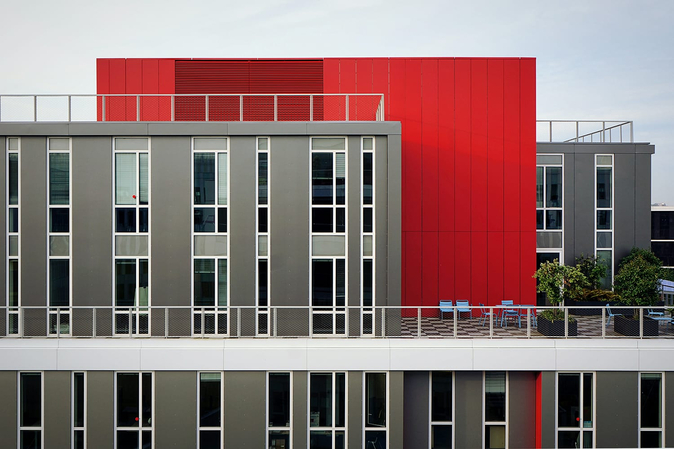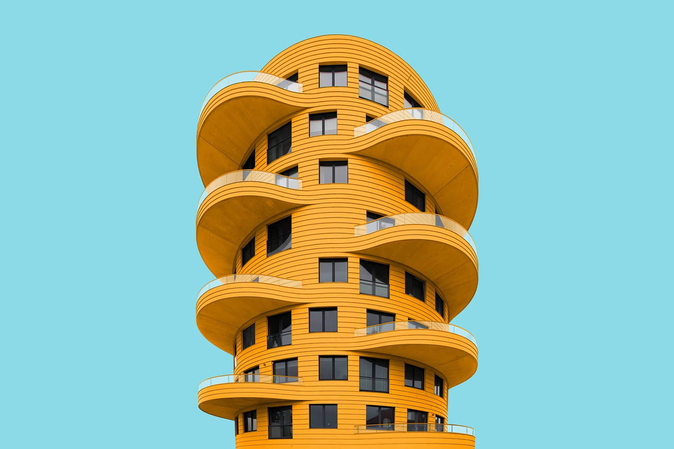15 Tips for Developing Your Architectural Photography Techniques
Architectural photography techniques form the foundation of capturing not just images of buildings, but also the emotion, purpose, and design intricacies embedded within each structure. From towering urban skyscrapers to quiet rural chapels, every piece of architecture tells a story, and photography is a powerful medium to express that narrative visually. In today's visually driven world, where architecture often defines the character of cities and communities, learning how to document these designs with precision and creativity is an essential skill.
This article is crafted to offer both inspiration and practical guidance, helping you improve the way you photograph buildings and develop a deeper appreciation for the architectural world around you.
Part 1: Understanding Architectural Photography

Architectural photography involves capturing the built environment in a visually appealing and meaningful way. It's more than just pointing your camera at a structure and pressing the shutter. At its core, architectural photography is about interpretation-telling the story of a building's form, function, and relationship to its environment. This genre of photography demands a strong eye for detail and an understanding of how different architectural elements-like lines, shapes, textures, and light-come together to form a cohesive image.
Unlike casual photos of buildings, professional architectural images are carefully composed to emphasize the uniqueness of a design. They respect symmetry, highlight craftsmanship, and often require multiple visits to capture the perfect light or weather condition. There's also a distinction between taking an architectural image and simply trying to photograph a building. A snapshot may record what something looks like, but a great architectural photograph communicates feeling, scale, and intention.
Part 2: 15 Essential Tips for Best Architectural Photography

1. Invest in the Right Gear
One of the foundational architectural photography techniques is using equipment suited to the demands of the genre. High-quality images often begin with the right camera body-preferably a full-frame DSLR or mirrorless model that offers manual settings and a high dynamic range. However, the real game changer is your choice of lens. Wide-angle lenses are commonly used to capture the full scale of a structure, especially when space is limited. Tilt-shift lenses are particularly valuable for correcting perspective distortion and keeping vertical lines true, which is crucial when photographing tall buildings.
Accessories also matter. A high-resolution camera helps preserve detail in large prints or zoomed-in shots. Investing in spare batteries, memory cards, and lens cloths ensures you're always prepared, especially during extended shoots.
2. Use a Sturdy Tripod
A tripod is more than just a stability tool-it's a creative asset. It allows for long exposure shots, perfect framing, and consistent series images. Architectural photography often involves slow shutter speeds, especially in low-light conditions or when shooting indoors. Without a tripod, you risk camera shake and blurred results, undermining the quality of your work.
Moreover, using a tripod encourages thoughtful composition. When you're locked into a fixed position, you spend more time considering your framing, balance, and alignment. It can turn a casual shot into a perfectly composed masterpiece. Even when lighting is sufficient for hand-held shooting, a tripod remains an invaluable part of your toolkit.
3. Utilize Filters
Filters can significantly enhance your architectural images. A circular polarizer reduces reflections from windows and water surfaces, boosts sky contrast, and adds clarity to textures. This is especially helpful when photographing modern glass buildings where unwanted glare can obscure detail. Neutral density (ND) filters, on the other hand, allow for longer exposures during daylight, enabling you to create artistic effects such as streaking clouds or smoothing water features-adding motion and mood to your compositions.
Using filters not only gives you more creative control, but also reduces post-processing workload by improving image quality right out of the camera.
4. Keep Vertical Lines Straight
One of the cardinal rules of best architectural photography techniques is maintaining straight vertical lines. Buildings are designed with structural precision, and tilting lines distort the viewer's perception. Unless done intentionally for artistic effect, crooked lines can make an image look amateurish. The most reliable way to manage this is through a tilt-shift lens, but if that's out of reach, many modern editing programs like Lightroom and Photoshop offer perspective correction tools.
Some cameras also feature in-built leveling guides to help maintain alignment during shooting. Being mindful of your angles and making subtle adjustments can dramatically increase the professionalism of your work.
5. Explore Different Perspectives
Photographing a building from eye level may capture its form, but experimenting with angles can reveal far more. Try one-point perspective for a centered, symmetrical image that draws the eye into depth. Two-point perspectives showcase multiple sides of a structure, offering a broader sense of its scale and design complexity.
A building often looks dramatically different when photographed from above, below, or its corners. Don't hesitate to lie on the ground or climb a nearby structure (safely) for a more dramatic shot. Playing with perspective is a great way to give your images a unique and memorable character.
6. Capture Details and Context
Don't just focus on the entire structure-zoom in to highlight textures, engravings, and craftsmanship. Some of the most compelling architectural shots are found in the small details: a hand-carved railing, a sunlit windowpane, or a weather-worn door handle.
Equally important is context. Include elements such as nearby trees, people, or other structures to show how the building interacts with its environment. This context provides scale and narrative, helping the viewer better understand the structure's place and purpose.
7. Time of Day Matters
Lighting can make or break an architectural photo. The magic hour-shortly after sunrise or before sunset-casts a golden hue, creating long shadows and rich textures. It's the perfect time to emphasize form and depth. The blue hour, occurring after sunset, offers soft, ambient lighting and a tranquil mood ideal for modern and glass-heavy buildings.
Avoid shooting under harsh midday sun when shadows are sharp and colors are flat. Instead, scout the location ahead of time to understand how light plays on the structure throughout the day.
8. Embrace Varied Weather Conditions
While blue skies are appealing, they're not always ideal. Cloudy days offer soft, diffused lighting that reduces harsh shadows. Rain adds reflections and emotional depth, while snow creates contrast and texture. Fog, meanwhile, can evoke mystery and focus attention on specific architectural features.
Being flexible with weather conditions allows you to produce a more diverse and engaging architectural portfolio.
9. Understand Natural Light
Mastering how to photograph architecture involves understanding how natural light interacts with your subject. Different materials respond differently-glass reflects, brick absorbs, and metal gleams. Pay attention to the time and angle of sunlight. Backlit structures can form silhouettes, while side lighting brings out depth and texture.
Also, consider seasonal changes. Winter light is colder and lower, while summer brings brighter, more direct sun. These nuances affect the final mood and clarity of your image.
10. Understand Shutter Speed and Aperture
Aperture and shutter speed are critical tools in the architectural photographer's toolbox. A narrow aperture (e.g., f/11-f/16) ensures deep focus from foreground to background, which is ideal for sharp images of buildings. Meanwhile, slow shutter speeds are great for creative effects-such as capturing light trails at night or softening moving elements like fountains or clouds.
Understanding how to balance these settings allows you to achieve technically strong and visually stunning compositions.
11. Stabilize Your Camera
In addition to using a tripod, consider using a remote shutter release or your camera's timer to minimize vibration. Even the slightest shake can blur the fine lines and intricate textures that define architectural images.
If you're shooting handheld, engage image stabilization and increase your shutter speed slightly. Keeping your camera steady ensures every corner, brick, and beam remains crisp and defined.
12. Post-Processing with Intention
Editing is a vital part of modern photography, especially when refining architectural shots. Adjustments to contrast, exposure, and perspective can enhance the image without distorting reality. Avoid overly aggressive edits-too much saturation or HDR can make your image appear unnatural.
An Amazing App for Photo Enhancer: HitPaw Photo Enhancer

For photographers who want professional-grade enhancement without learning complex software, HitPaw Photo Enhancer is an excellent option. This AI-powered tool improves sharpness, restores old photos, removes noise, and even enlarges images with no loss in quality. It's particularly effective for architectural photography, where preserving clean lines and fine details is crucial.
13. Scout Locations in Advance
Preparation leads to better results. Visit your shoot location ahead of time, ideally during the time of day you plan to photograph. Note the lighting conditions, obstructions, and potential shooting angles. This also helps in planning for required gear, permits, and access restrictions.
Scouting allows you to anticipate challenges and seize opportunities you might otherwise miss in a rushed shoot.
14. Experiment and Adapt
There's no single formula for success in architectural photography. While techniques and rules are important, creativity lies in breaking them. Try abstract compositions, shoot at night, incorporate human elements, or experiment with long exposures. Adapting your approach based on the structure and setting keeps your work fresh and original.
Be open to unexpected results-they often lead to your most creative breakthroughs.
15. Attention to Detail
The smallest elements can make or break a photo. Check for distracting items like trash bins, power lines, or lens flare. Clean your lens regularly and watch for smudges or water spots. Also, take multiple shots from the same position to ensure at least one is perfectly in focus and exposed.
Paying attention to every detail ensures your final image is polished and professional.
Part 3: Conclusion
Great architectural photography combines artistic vision with technical excellence. Whether you're drawn to historic landmarks or futuristic skyscrapers, applying these architecture photography tips can significantly elevate your results.
By understanding the importance of light, gear, perspective, and timing, you'll develop a sharper eye and a stronger creative voice. The best way to grow is to keep practicing, explore diverse styles, and never stop learning about how to photograph architecture in ways that express your unique perspective.
We'd love to hear from you! Share your photos, experiences, or additional tips in the comments, and let's continue building a community passionate about exceptional architectural photography techniques.










 HitPaw Univd (Video Converter)
HitPaw Univd (Video Converter) HitPaw VoicePea
HitPaw VoicePea  HitPaw VikPea (Video Enhancer)
HitPaw VikPea (Video Enhancer)



Share this article:
Select the product rating:
Daniel Walker
Editor-in-Chief
This post was written by Editor Daniel Walker whose passion lies in bridging the gap between cutting-edge technology and everyday creativity. The content he created inspires the audience to embrace digital tools confidently.
View all ArticlesLeave a Comment
Create your review for HitPaw articles